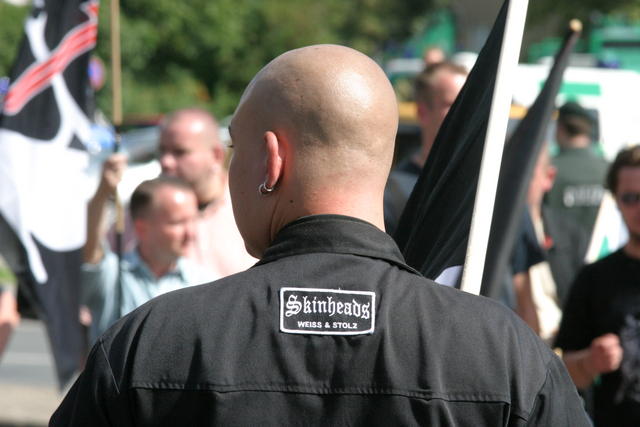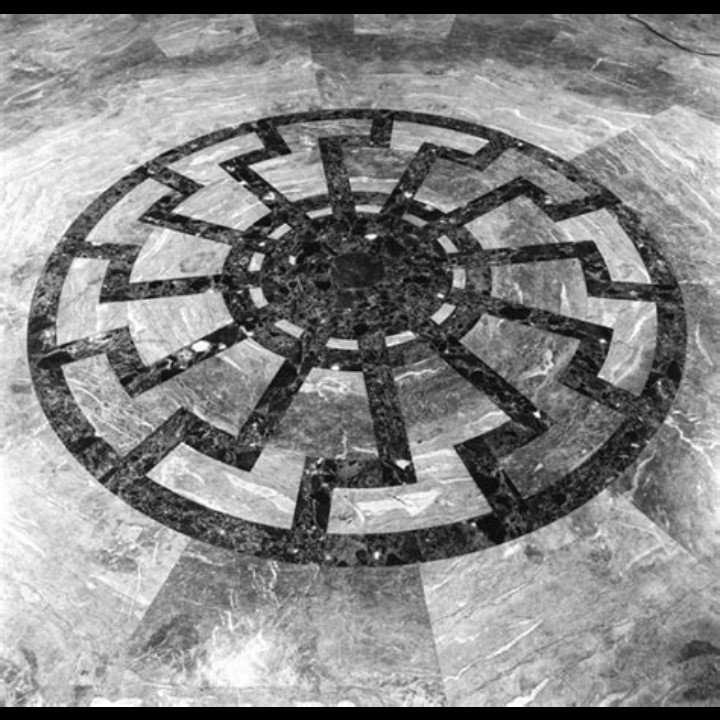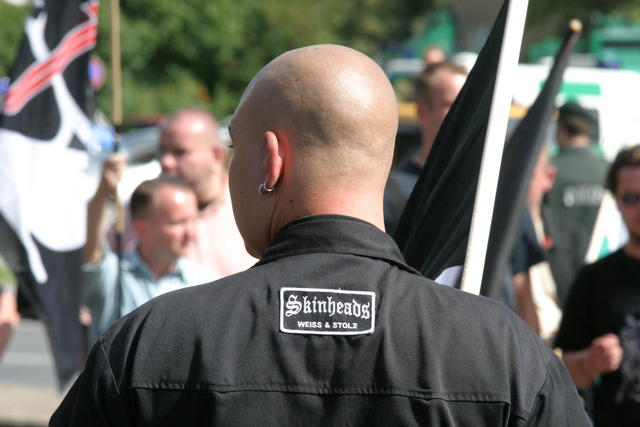The far right in Czechia has mutated over the past decade. Once limited to skinheads in bomber jackets, it now blends politics, gyms, and business into a dangerous new face of extremism. This piece examines how the far right in Czechia blends aesthetics, violence, politics, and business.

The Czech far right has learned how to mutate. It is no longer just shaved heads in bomber jackets and boots. Now they copy the aesthetics of their antifascist rivals, infiltrate gyms and boxing clubs, appear on municipal election lists, and even secure million-crown contracts with ministries in the middle of a pandemic.
At the same time, other groups rehearse a more respectable disguise. They choose shirts and conferences, projecting an image of legitimacy. In parallel, paramilitary factions emerge. They train in forests, wear uniforms, and venerate symbols inherited from the Third Reich. Meanwhile, at the political summit, figures like Tomio Okamura turn hostility toward foreigners into a platform for power.
Aesthetics, violence, business, politics, and symbolic cults: these are five faces of the same phenomenon. It grows quietly, yet with far too much impunity.
The stolen image
For years, the Czech far right dressed in bombers, boots, and skinhead style. Today, part of those factions has adopted the “black bloc” image: black hoodies, full-body dark clothing, sunglasses, and masks. A style born in anarchist and antifascist circles in the 1970s is now shamelessly copied by neo-Nazis. The aim is clear: uniformity, anonymity, and confusion—so much so that from afar it can be hard to tell whether one is looking at an antifascist bloc or a far-right group. The paradox is evident: a movement that preaches “order and tradition” hides beneath an aesthetic borrowed from its ideological enemies. This aesthetic camouflage helps the far right in Czechia blur lines and avoid accountability.
From disguise to violence
“Decent People” and other neo-Nazi groups adopted the typical antifascist look: black clothes from head to toe—hoods, sports sweatshirts, and masks. With this disguise, they seek uniformity and anonymity, copying the black bloc style that emerged in the 1970s in anarchist circles. The irony is that those who proclaim “order and tradition” rely on the image of their enemies to project strength on the streets. But imitation did not remain symbolic: it soon translated into violence directed against minorities. For a broader chronology, see Attacks against minorities in Czechia: a timeline. These tactics reveal how the far right in Czechia turns borrowed aesthetics into targeted violence.
From the ring to municipal politics
Kalina’s path from hooliganism to politics
In 2018, Jaroslav Kalina, barely in his twenties, appeared as a candidate for the “Decent People” movement in Brno’s municipal elections. To the general public he was an unknown face. However, he had spent years in the city’s hooligan and neo-Nazi environment. A regular in gyms and boxing clubs frequented by members of the JKG group, photos show him alongside figures such as Vladan Weiss and the Lebeda brothers, notorious for football brawls and racist assaults.
Sportswear as a façade for extremism
Kalina had no relevant political or business experience. Even so, his entry on the electoral lists showed how violent circles were beginning to seek a façade of respectability through the ballot box. Unlike the classic skinhead look of bomber and boots, members of “Decent People” often wear sports gear: dark sweatshirts, tracksuit pants, brand-name sneakers, and occasionally light jackets or caps. This “training” aesthetic reinforces their ties to boxing clubs while allowing them to blend in as ordinary neighborhood youth. Moreover, the absence of explicit Nazi symbols does not erase the ideological background. It is simply a practical façade concealing networks of hooligans and militants with records of racist violence.
Violence documented on video
Around 2020, a video broadcast by DNES TV showed Weiss brutally attacking a young Tunisian in the center of Brno, chosen at random for his skin color. He knocked him down from behind and struck him repeatedly in the head while shouting insults like “dirty Arab.” In 2022, the courts sentenced him to seven and a half years in prison. Nevertheless, the judiciary avoided recognizing the racist motive. Kalina trained at the same boxing club as Weiss—Brenner—pointed out as a hotbed of the local neo-Nazi scene.
From gyms to local politics
That someone from this circle could appear on an electoral list illustrates how the violent far right has learned to whitewash itself under the guise of “respectable” political projects. These gyms therefore became pipelines for the far right in Czechia to enter local politics.
Double judicial standards
The contrast is striking. In Brno, Vladan Weiss was convicted for his brutal assault on a Tunisian youth. Yet the court avoided acknowledging racial hatred as the motive. However, there are even more alarming cases. A young refugee, also attacked by a neighbor linked to neo-Nazi circles, suffered serious injuries documented with medical certificates. The police shelved the case, manipulated key evidence, and ultimately accused the assaulted man himself. The process was rigged and even received the prosecutor’s approval.
The paradox is cruel. The aggressor, tied to a violent racist environment, was protected by institutional inaction. Meanwhile, the foreign victim was treated as the suspect — a pattern I analyzed further in Racism and exclusion in Czechia. This double standard sends a devastating message to minorities: reporting an attack can turn into a new form of persecution. As a result, such decisions normalize impunity for the far right in Czechia and intimidate victims.
A multimillion-crown contract in the middle of a pandemic
Normalization also manifests in business. In April 2020, while the Czech Republic was desperately seeking masks and respirators, a small company named Supervize Hologramy s.r.o. appeared as an unexpected supplier. The firm was founded by 24-year-old Jaroslav Kalina, tied to Brno’s hooligan and neo-Nazi scene. Originally, the company had been created for hologram services, not medical equipment.
Nevertheless, it signed a contract with the Ministry of Health for 400,000 FFP2 respirators worth 72.6 million crowns. According to Seznam Zprávy, Kalina bought them in China for 38 crowns each and resold them to the state for 150, applying a markup of about 300%. In addition, the ministry transferred an extra 37 million crowns “by mistake.”
The deal revealed how, in the middle of a national emergency, a twenty-something with no background in the sector ended up handling a multimillion-crown state contract. As a result, the margins scandalized public opinion and exposed the state’s permeability to networks with extremist connections. The pandemic windfall illustrates how the far right in Czechia profits from crisis and weak oversight.
The aesthetics of the Reich recycled in Czechia

“Black Sun” (Schwarze Sonne), an esoteric symbol designed by the Nazi SS, has been recovered today by Czech ultranationalist groups. They display it on social media combined with paramilitary aesthetics.
Beyond the hooligan-styled street bands, another profile emerges. It hides behind a paramilitary or cultural-tradition façade. On social media, tattoos and patches act as ideological passwords. Germanic runes like algiz, odal, the Wolfsangel, or the double sig—once used by SS divisions and other Hitlerite formations—are now revived as identity markers by young people who know exactly what they mean.
The Thor’s hammer becomes an emblem of ethnic resistance. Imperial eagles in black and white directly evoke the Third Reich. In addition, slogans like White Lives Matter are framed within rune circles. Even seemingly neutral symbols, such as the dollar pyramid with the all-seeing eye, are reinterpreted in conspiratorial narratives about a supposed “new world order.”
The staging goes hand in hand with the visual language. Camouflage uniforms, tactical vests, forest trainings, shooting practice, and flags with archaic emblems reinforce the message. These groups organize into “units” with pompous names, as if they were regiments waiting for deployment. From the outside, they look like men preparing for war. Moreover, reviewing their profiles shows that the enemy they name is not abstract. It is the supposed “invasion of immigrants,” a discourse copied straight from the European far right.
The absence of swastikas does not make them harmless. On the contrary, the message is encoded in the symbols they proudly display. Military camouflage becomes the visual translation of a permanent siege mentality. As a result, these coded symbols legitimize and spread that mentality across the far right in Czechia.
The façade of Generace Identity
In parallel, Generace Identity, the Czech branch of the European Generation Identity movement, bets on a more respectable façade: conferences, pamphlets, and public events where members appear in shirts and formal clothing. The rhetoric replaces “race” with “identity” or “ethno-pluralism,” but the goal remains unchanged: portraying diversity as a threat and promoting a “Europe for Europeans only.”
Local studies and media point to Adam Berčík (Ústí nad Labem) as the most visible face of the group, along with Michal Urban (Prague) and Ladislav Havlíček (Veselí nad Lužnicí), all previously connected to the Autonomní nacionalisté. Facebook even blocked the organization’s accounts for violating rules against extremism.

Their trajectory shows continuity: from the old autonomous nationalists to today’s identitarians in white shirts at podiums. A change of aesthetics that is little more than a rebranding of the same far-right ideology. This respectable veneer is little more than a rebranding of the far right in Czechia.
The paradox of Tomio Okamura
The legitimization strategy is not confined to marginal groups. Instead, it extends to national politics. Tomio Okamura, leader of SPD, was not born in the Czech Republic. He was born in Tokyo in 1972 to a Japanese father of Korean origin and a Moravian mother. According to Wikipedia, he spent part of his childhood in an orphanage despite having living parents. Moreover, he recalls that period as marked by bullying due to his Asian features. At age ten, he returned with his mother to Czechoslovakia, where he grew up and studied.
Okamura’s background and early life
That background did not lead to empathy. On the contrary, as an adult he became one of the harshest politicians against immigration. In 2018, during a rally in Prague, he declared that “refugees are parasites” (Seznam Zprávy, 6/2018). He also argued that foreigners who lose their jobs “should not automatically receive social benefits” (novinky.cz). In addition, he promoted laws providing for the automatic expulsion of foreigners who commit intentional crimes, with few exceptions (demagog.cz).
Citizenship law and migrant children in limbo
The contrast with the real lives of many migrant families in Czechia is striking. The Citizenship Act (Act No. 186/2013 Sb., §§ 5 and 29) stipulates that children of asylum seekers or foreigners born in Czech territory do not receive citizenship automatically. Instead, they must wait until age 18 to apply. Consequently, today there are children aged 12–13, born in Czech hospitals to political asylum seekers, who attend local schools, speak Czech as their mother tongue, and know no other homeland. Yet they are still considered “foreigners” under the law.
The paradox of exclusion
Meanwhile, these minors grow up in legal limbo. Okamura—a man who as a child felt the stigma of being treated as foreign—uses his political power to stigmatize those who came after him. The contradiction could not be sharper. Someone who once suffered rejection for his origins now turns that very rejection into his political platform. As a result, this paradox exposes the double standards of Czech politics. I explored it further in my analysis of .Okamura’s 2025 campaign.
How Trump’s Antifa signal echoed in the far right in Czechia
According to Seznam Zprávy, in 2020 Donald Trump announced he wanted to include Antifa on the list of terrorist organizations. In the U.S., however, the legal framework does not allow domestic groups to be designated as terrorists—only foreign organizations can. His statement was, in practice, symbolic.
In Czechia, however, that gesture resonated strongly. The far right celebrated it, and leaders of Tomio Okamura’s SPD cited it as an example of what should, in their view, be applied here as well. The irony is clear. While attempts are made to criminalize a movement born in the 1930s to fight Nazism, neo-Nazi groups spreading racial hatred remain largely untouched.
By contrast, these same neo-Nazi groups organize attacks and parade with coded symbols, yet they are rarely labeled as terrorist organizations. As a result, the double political and judicial standard not only whitewashes the far right but also casts suspicion on the very movement that historically confronted fascism. This transatlantic echo ultimately helped the far right in Czechia normalize its narrative while shifting suspicion onto antifascists.
